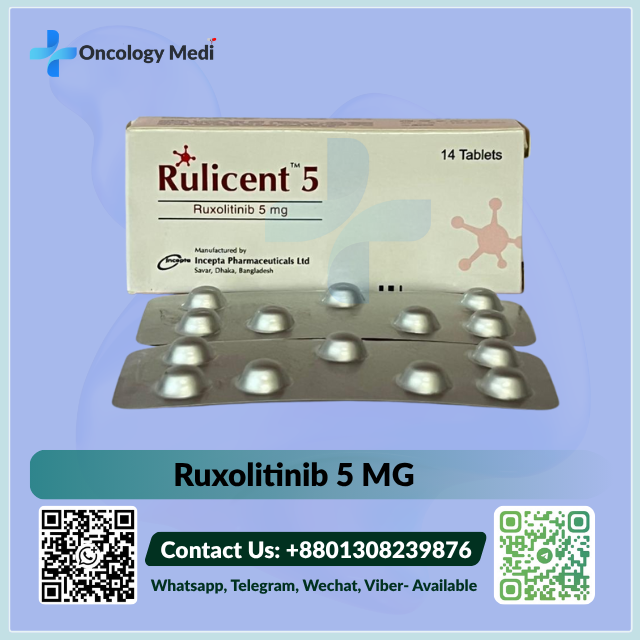Description
Rulicent 5 mg contains Ruxolitinib, a potent Janus kinase (JAK) asset used most specially in the treatment and operation of certain blood diseases and seditious skin conditions. It’s shamefaced of conditions that involve hyperactive signaling of the JAK- STAT pathway that results in aberrant blood cell development and vulnerable system exertion. Rulicent is extensively used in myelofibrosis, polycythemia vera, and graft- versus- host complaint (GVHD) conditions and for topical or systemic treatment of atopic dermatitis and vitiligo.
Composition and Formulation
Each tablet of Rulicent 5 mg has the active component Ruxolitinib 5 mg. The expression may also have inactive factors similar as lactose monohydrate, microcrystalline cellulose, and magnesium stearate to give stability and bioavailability. The drug is also presented in the tablet form for oral administration, making it accessible for diurnal use under a doctor’s tradition.
Mechanism of Action
Ruxolitinib, the active substance of Rulicent, specifically inhibits the Janus- associated kinases (JAK1 and JAK2) — significant enzymes to execute signals from cytokines and growth factors to play places in hematopoiesis and vulnerable function. In conditions similar as myelofibrosis or polycythemia vera, exorbitantly heightened stimulation of theses pathways leads to abnormally developed and performing blood cells.
By inhibiting JAK1 and JAK2, Rulicent 5 mg corrects blood cell product, prevents inflammation, and reduces spleen size in myelofibrosis cases. In dermatology, it inhibits vulnerable- mediated inflammation and relieves the symptoms of habitual skin conditions similar as eczema and vitiligo.
Therapeutic Indications
Rulicent 5 mg is used in different medical conditions, including
Myelofibrosis (MF) – Used in intermediate- or high- threat cases with MF, either primary MF,post-polycythemia vera MF, orpost-essential thrombocythemia MF. It relieves symptoms like fatigue, night sweats, and splenomegaly.
Polycythemia Vera (PV) – For hydroxyurea- resistant or intolerant cases, Rulicent reduces hematocrit and phlebotomy requirements.
Acute and habitual Graft- Versus- Host Disease (GVHD) – Helpful in inadequately responding corticosteroid cases. diminishments vulnerable response modulation and inflammation.
Atopic Dermatitis( Eczema) – Decreases itching, erythema, and skin inflammation in moderate- to-severe atopic dermatitis, especially in inadequately controlled cases with topical remedy.
Vitiligo – Reverses skin saturation by modulating vulnerable mechanisms for the destruction of melanocytes.
Dosage and Administration
Cure of Rulicent 5 mg is personalize according to the condition, patient response, and original blood counts. Generally
In Myelofibrosis, the starting dose is frequently platelet- driven, 5 mg to 20 mg twice a day.
In Polycythemia Vera, the starting dose is frequently 10 mg doubly daily.
GVHD, the boluses generally begin with 5 mg doubly daily and can be increase according to response.
For Dermatologic diseases, the duration and cure are regulate by the doctor as per the inflexibility of the complaint and case forbearance.
Tablets should be taken orally with or without refections, at the same time daily. This will keep the medicine at constant situations in the blood.
Side Effects
Like all medicines, Rulicent 5 mg (Ruxolitinib) has side effects, but they aren’t endured by all. The most common are:
Hematologic effects: Anemia, thrombocytopenia (low platelet count), and neutropenia (low white blood cells).
Infections: Increased threat of bacterial, viral, or fungal infection, including herpes zoster (shingles).
Metabolic Changes: Gain in weight, rise in cholesterol, and high liver enzymes.
Gastrointestinal Symptoms: Diarrhea, nausea, or abdominal discomfort.
Other effects: Dizziness, fatigue, or headaches in some cases.
Regular blood tests are needed in cases to cover blood counts and liver function during treatment.
Precautions and Warnings
The threat of Infection Ruxolitinib increases the threat of infection. Fever, chills, or cough should be report instantly.
Monitoring Blood Count Complete blood counts (CBC) need to be teste regularly to acclimate the cure and help complications.
Liver Function Caution with hepatic impairment; dose adaptation may be need.
Immunosuppression: Concurrent use with other potent immunosuppressive medicines is to be avoid except in discussion with a doctor.
The gestation and Lactation Safety of Ruxolitinib is inadequately established during gestation or lactation and should only be administered if absolutely necessary under medical supervision.
Drug Interactions
Rulicent interacts with other medicines that are metabolize by the CYP3A4 enzyme system. Use caution when administered concomitantly with
Strong CYP3A4 impediments (e.g., ketoconazole, clarithromycin) – tends to increase Ruxolitinib situations and threat of toxin.
Strong CYP3A4 corrupters (e.g., rifampin, phenytoin) – reduces its efficacity.
Other immunosuppressants or biologics – may raise pitfalls of infection.
Notify all medicines or salutary supplements to the doctor.
Storage Instructions
Store Rulicent 5 mg tablets at room temperature (below 30 °C), in a dry terrain, and out of direct sun. Store the medicine beyond the reach of children and faves. Don’t use it past the expiry date on the package.
Conclusion
Rulicent 5 mg (Ruxolitinib) is a significant advancement in the operation of hematologic malice and vulnerable-affiliated conditions. By inhibiting the JAK-STAT signaling pathway, itre-establishes equilibrium in blood cell development and impunity, bringing relief to cases who have else untreatable conditions. Still, due to its strong impact on the vulnerable and hematopoietic system, close monitoring and medical supervision are need during treatment. When used correctly, Rulicent 5 mg possesses the capability to ameliorate dramatically quality of life and complaint status in cases with habitual seditious and hematologic diseases.






Reviews
There are no reviews yet.